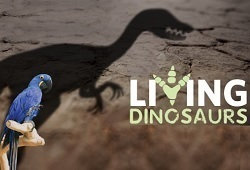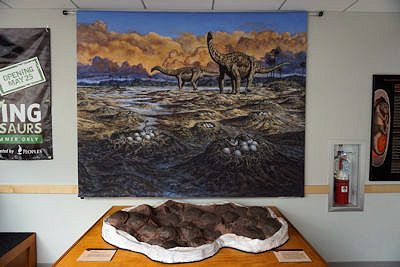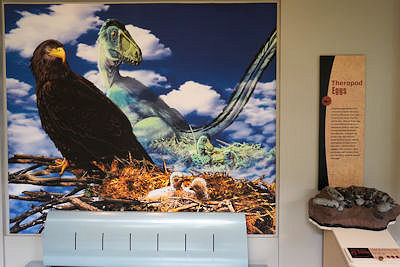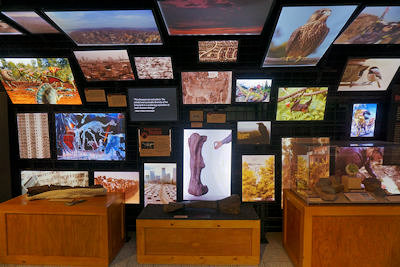
Pittsburgh is the home of a multitude of dinosaurs. Fossil remains are on display at the Carnegie Museum of Natural History, for instance, while remnants of the 2003 outdoor art exhibit DinoMite Days still dot the area and a life-sized replica of the world-renowned Dippy stands tall in the Oakland section of the Steel City.
On the North Side, however, are actual living, breathing dinosaurs. In fact, hundreds of them can be seen on any given day. That is not to say that Pittsburgh has a real world Jurassic Park within its city limits as these dinosaurs are part of the National Aviary and more commonly referred to as birds.
Although dinosaurs were originally believed to be giant lizards with small brains that sluggishly lumbered across a prehistoric landscape, it is now accepted fact that the likes of Tyrannosaurus Rex and Velociraptor were ancient ancestors of modern eagles, seagulls, and hawks. Over the summer of 2019, the National Aviary highlighted these ancestral roots with a special exhibit entitled – appropriately enough – Living Dinosaurs.
Although the theory that birds descended from dinosaurs has been around since the time of Charles Darwin, it wasn’t until the early 1970s and the efforts of Yale University professor John Ostrom and his student Robert Bakker that it gained widespread acceptance. It was slowly becoming evident that dinosaurs shared many of the same attributes as birds – and for Ostrom and Bakker, it wasn’t that far of a leap to make the evolutionary connection.
So what exactly are these shared characteristics? First is there is the physical – an abundance of dinosaurs walked upright on back legs with feet containing three skinny toes, just like birds, and later developed wishbones and an s-shaped neck as well. Of more significance, however, are the unique lung and internal bone structures that they both share.
“While mammals have a simple lung that breaths in oxygen and exhales carbon dioxide, birds have what is called a unidirectional lung” paleontologist Steve Brusatte explains in his 2018 book The Rise and Fall of the Dinosaurs. “Air flows across it in one direction only, and oxygen is extracted during both inhalation and exhalation. The bird-style lung is extra efficient, sucking up oxygen with each breath in and each exhalation.”
Fossil studies have shown that dinosaurs had the same type of lungs. “Many bones of the chest cavity (of dinosaurs) have big openings, called pneumatic fenestrae, where the air sacs extended deep inside,” Brusatte continues. “They are exactly the same structures in modern birds, and they can only be made by air sacs. It turns out that air sacs also have another function. Aside from storing air during the breathing cycle, they also lighten the skeleton when they invade the bone. In effect, they hollow out the bone so that it still has a strong outer shell but is much more light weight.”
These two design features are what allowed the Tyrannosaurus Rex to grow into predatory goliaths without running out of the oxygen needed to support its size, and also enabled sauropods like Brachiosaurus and Diplodocus to effortlessly move without toppling over or crumbling to the ground. Today, these lung and bone anomalies are what allow birds to fly.
Lastly, there’s the most birdlike feature of all – feathers. Dinosaur fossils are replicas of bones, while skin, muscles, internal organs, and feathers cannot be preserved in nature under the circumstances that led to these fossils. Because paleontologists historically only had bone fossils at their disposal, it was impossible for them to determine if dinosaurs also shared a feathered correlation with birds.
That changed in the late 1990s when dinosaur fossils discovered in the Liaoning region of northeastern China contained a halo of feathers surrounding the bones. In prehistoric times, the area was a dense forest surrounded by ancient lakes and active volcanos. When the ash from an erupting volcano mixed with the lake water, the ensuing rush of hot liquid created a unique set of circumstances that instantaneously preserved any dinosaur in its path – including their feathers.
While Living Dinosaurs at the National Aviary highlighted all of these connections, the exhibit’s primary focus was on dinosaur eggs and nesting habits. Throughout the halls of the Aviary – directly across from the living and breathing bald eagles, canaries, and penguins – were egg fossils, signage that told the stories of recent discoveries, and artwork depicting life in the Age of Dinosaurs.
Although the first dinosaur nest and fossilized eggs were discovered in 1923, they were initially considered oddities by scientists as opposed to finds worthy of further research. When famed dinosaur hunter Jack Horner unearthed the first dinosaur eggs in North America in 1978, his discovery changed the way paleontologists thought about both eggs and dinosaurs.
As the Living Dinosaurs exhibit explained, “Horner discovered evidence that Maiasaura provided some parental care for their hatchlings. Fifteen partially-grown nestlings with incompletely developed bones were found in one nest, indicating at least one parent provided food for these nest-bound babies.”
In 1993, meanwhile, Mark Norell of the American Museum of Natural History unearthed a nearly complete skeleton of the carnivorous Oviraptor in the Gobi Desert of Mongolia. More significantly, the legs of the skeleton were tucked under the body and its arms were wrapped around a nest of eggs, suggesting that the dinosaur died while protecting its unborn offsprings.
The parenting habits of dinosaurs were originally thought to have been nonexistent – they laid their eggs then left the newborns to fend for themselves. Norell’s discovery in Mongolia suggests that dinosaurs were just as protective of their nests as modern birds, and contempory paleontologists now believe that dinosaurs even cared for their young for years after birth.
“The reign of the dinosaurs ended and a revolution followed, forcing them to cede their kingdom to other species,” Steve Brusatte writes in The Rise and Fall of the Dinosaurs. “But a few stragglers made it through, a few dinosaurs that had what it took to endure. The descendants of these remarkable survivors live on today as birds, the enduring legacy of over 150 million years of dinosaur domination, of a dead empire.”
Over the summer of 2019 the story of these dinosaur ancestors was presented side-by-side with their present-day descendants at the National Aviary in Pittsburgh – descendants who, in essence, are Living Dinosaurs.
Anthony Letizia





